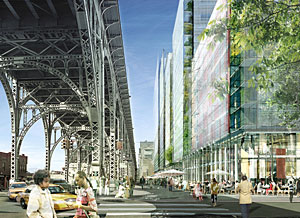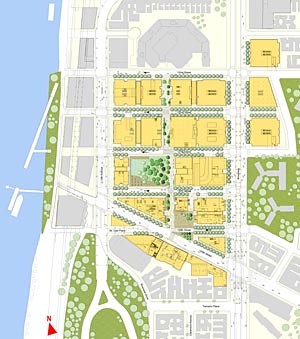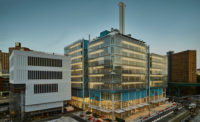Renzo Piano is not bashful about his plan to raze century-old, masonry-clad factories and tenements in West Harlem and replace them with big, crisp buildings of steel and glass—a new campus for Columbia University that resembles Metropolis more than it does the existing neighborhood. “Cities are bound to change,” he says, “You have to accept it.”

Created by Renzo Piano and SOM, Columbia University’s new 17-acre campus will replace low-rise warehouses and tenements with glass-walled towers.


Pressed for space at its original campus in Morningside Heights, 10 blocks south, Columbia hired Piano in 2003. He created a sprawling, city-within-a-city that covers 17 acres with 6.8 million square feet of box-shaped towers; Skidmore Owings & Merrill formulated the urban plan. But to make way for this development, Columbia must contend with three privately owned warehouses that refuse to sell, including one that was recently added to the National Register of Historic Places. Its plan to demolish them is raising the specter of eminent domain and pitting Columbia against Harlem residents.
Piano says the results will be worth the controversy. Punctuated by tree-lined quads, his buildings are meant to bring a new, open sense to the neighborhood. Their ground floors will host retail stores and restaurants. “We put the dirty functions—garbage, ramps, parking, and loading—underground, because they make a very opaque environment, and we put the research facilities up higher, so that everything on the ground is more transparent and public,” he explains.
Columbia’s plan took a big step forward this summer following the completion of an environmental impact statement and feasibility study by Thornton Tomasetti and AKRF. The city’s Planning Department is scheduled to start the land review process today, giving the local Community Board 60 days to review Columbia’s plans and suggest changes. If approved, construction would be completed in two phases: the first by 2015, the second by 2030. Meanwhile, the Community Board’s own plan, called 197A—which includes more preservation and avoids eminent domain—goes before public hearings in July.
Developing a new campus almost as big as the original one requires extensive dialogue with neighborhood residents, Piano concedes. “Listening is a very tough job, because you have to listen to the right voices, and sometimes the right voices are very little voices.” But residents wonder if, so far, the architect has listened only to Columbia. His plan calls for retaining only a handful of existing buildings: three small, brick structures dating to the early 1900s. They include a terra cotta-faced building where the architect makes his local office. “We saved buildings that will give a sense of the history of this neighborhood. It’s a mix of the past but, at the same time, the courage to go ahead and change,” he says.
Neighborhood residents and others contend that more preservation is warranted. “How can only three or four buildings preserve the character of a neighborhood,” says Eric Washington, author of Manhattanville, a history of the area. “That’s a lot of responsibility for four buildings.” Instead of demolishing some of the older structures, residents want Columbia to build its campus around them. “It has the opportunity to embrace such a rich community,” says Anne Whitman, owner of Hudson Moving and Storage, which could be seized if the state, prodded by Columbia, invokes eminent domain.
For its part, the university contends that an influx of shopping, dining, working, and living opportunities will quiet dissent. “This is an area that is going to change, and should change in significant ways,” says Columbia University president Lee Bollinger. It’s a sentiment that Piano shares: “You can’t embalm a city,” he says.
 Photo: © Charles Linn The owners of a storage facility slated for demolition protest Columbia's plans" |


Post a comment to this article
Report Abusive Comment